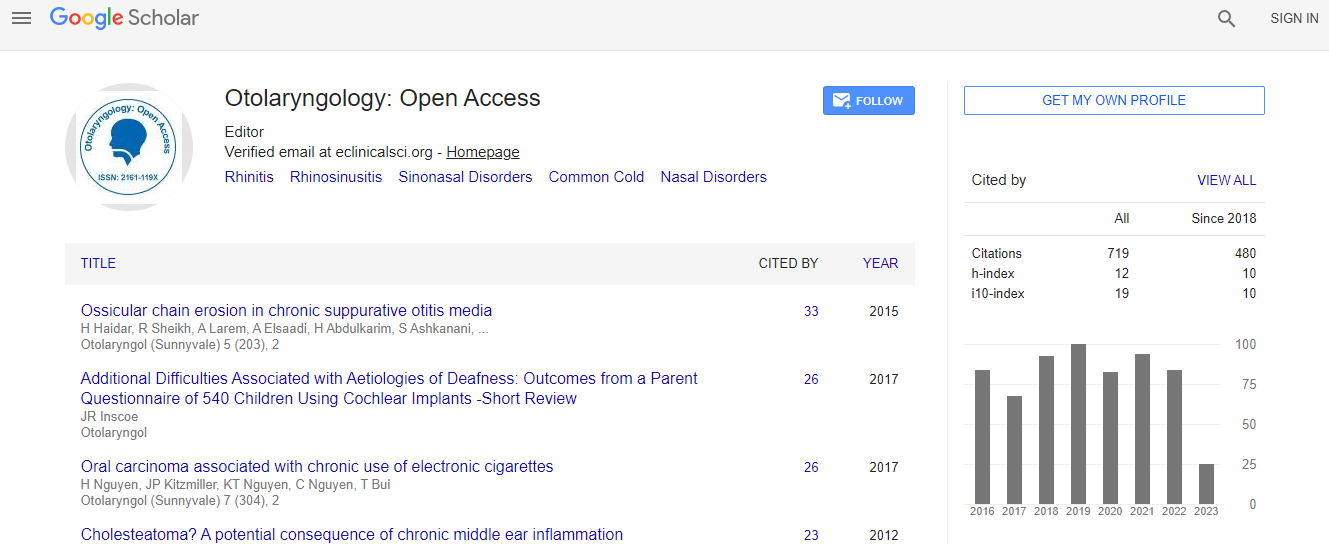Our Group organises 3000+ Global Conferenceseries Events every year across USA, Europe & Asia with support from 1000 more scientific Societies and Publishes 700+ Open Access Journals which contains over 50000 eminent personalities, reputed scientists as editorial board members.
Open Access Journals gaining more Readers and Citations
700 Journals and 15,000,000 Readers Each Journal is getting 25,000+ Readers
Google Scholar citation report
Citations : 925
Otolaryngology: Open Access received 925 citations as per Google Scholar report
Otolaryngology: Open Access peer review process verified at publons
Indexed In
- Index Copernicus
- Google Scholar
- Sherpa Romeo
- Open J Gate
- Genamics JournalSeek
- RefSeek
- Hamdard University
- EBSCO A-Z
- OCLC- WorldCat
- Publons
- Geneva Foundation for Medical Education and Research
- ICMJE
Useful Links
Recommended Journals
Related Subjects
Share This Page
The 1-3-6 timeline interprofessional simulation training
International Conference on Aesthetic Medicine and ENT
Ahmad A Alanazi
University of Arkansas for Medical Sciences, USA
Keynote: Otolaryngology
Abstract
Early detection of congenital hearing loss is critically important. Research tells us that if we find out a baby has hearing loss early, we can begin interventions and improve a child's ability to develop language and to learn and develop social skills. Universal neonatal hearing screening was legislated in many countries with a goal of meeting the 1-3-6 timeline (identification of hearing loss by one month, diagnosis by three months, and intervention by six months). This early identification and habilitation of deafness offers the child the best chances to develop communication skills commensurate with their typically hearing peers. The process of hearing loss identification, diagnosis, and intervention requires interprofessionl education/ practice (IPE/IPP) between ENT specialists, audiologists, speech-language pathologists, and other healthcare professionals. However, much misinformation exists among healthcare professionals with regard to this timeline. The Joint Committee on Infant Hearing reported that there is a shortage of professionals with skills and expertise in both pediatrics and hearing loss. This misinformation also appears among parents. For instance, the Arkansas loss-to-follow-up/loss-to-documentation rate was more than 70% in 2014. Therefore, the importance of IPE/IPP has been recognized by the Institute of Medicine as a major contributor to improving healthcare outcomes across the lifespan. The use of simulation (i.e., manikins and standardized parents who represent specific scenarions) can help to: (a) Conduct infant hearing screening and diagnosis, (b) counsel the parents regarding the results and next steps in the hearing loss identification and re/habilitation process, and (c) appreciate the benefits of the 1-3-6 timeline.Biography
Ahmad A Alanazi has completed his PhD and AuD degrees from University of Arkansas for Medical Sciences, USA and his Masters’ degree from Flinders University, Australia. He is a Lecturer at King Saud bin Abdulaziz Univeristy for Health Sciences, Saudi Arabia and an Adjunct Clinic Instructor at University of Arkansas for Medical Sciences. His research interests are broad but mainly focus on hearing loss detection and intervention, simulation, and interprofessional education/practice in which he has published several papers in peer-reviewed journal. His recent research focuses on the collaborative work among the healthcare professionals in meeting the 1-3-6 timeline via the use of simulation.
Email: AAAlanazi@uams.edu

 Spanish
Spanish  Chinese
Chinese  Russian
Russian  German
German  French
French  Japanese
Japanese  Portuguese
Portuguese  Hindi
Hindi 
